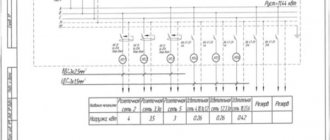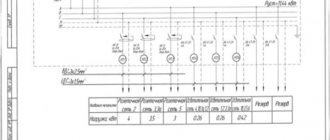Safe operation of electrical appliances is impossible without grounding. This ensures human protection from electric shock and guarantees long-lasting operation of household appliances. In old houses there is no protective grounding, but outdated energy supply systems are being replaced by new ones.
To make grounding in an apartment or private house yourself, you need to figure out what electrical system is present there and what is needed to connect it to the ground loop.
Why do you need grounding in an apartment?
Grounding means connecting a network point to a grounding device. With its help, they achieve a reduction in voltage to a level that is safe for humans. In other words, grounding is a protection that will work in the event of a hole, voltage surge or potential buildup, and will drain dangerous current into the ground.
Grounding can be operational or protective. If the first serves for the functioning of some specific electrical appliances and devices, then the second is intended to protect a person from electric shocks in an apartment or private house. Modern safety standards recommend laying internal electrical wiring of three cores and connecting all devices to a ground loop.
Reference! The color of the ground wire is in most cases yellow-green. Zero is blue or cyan, and phase can be black or red.
The following need grounding:
- sockets;
- household appliances with a metal body. In an apartment this includes a bathtub, a computer system case, a boiler, a refrigerator, a washing machine and other large household appliances.
Example of the need for grounding
The boiler installed to heat water in the apartment failed and shorted the electricity to the building. All the batteries and pipes in the apartment were under voltage. The unsuspecting man decided to drink water and tried to open the tap. The moment the hand touched the valve, the network closed and the current passed through the human body to the floor.
If the boiler were grounded, the current would go into the ground, and the machine would turn off the power supply to the device, or the batteries and pipes connected to the ground would have practically zero potential. In both cases, the electric shock could have been avoided.
Installation
The first thing you need to do is turn off the power in the electrical panel and you can verify this by connecting any electrical appliance. Next, we proceed to dismantling the old outlet. Clean the socket box from dust or remnants of finishing materials if something accidentally breaks off.
After you have identified the cable with the phase, one contact of the multimeter is fixed on it, and with the other you find the “ground”. 220V means that you have “zero”; if the indicator is less than this number, this is the ground wire. Also, according to the requirements, the wires must differ in color, which simplifies the task and makes it possible to remember which cable is which.
It's easy to remember:
- “Earth” – colored yellow-green (or simply yellow or green separately). It is routed to the bottom or middle terminal;
- “Zero” is almost always a blue cable, in rare cases it is replaced by a black one;
- The “phase” can be any color other than blue, yellow or green. In most cases it is white, red or brown.
What systems exist
In apartment buildings with a voltage of 220W, several grounding systems are possible, the basic standards and requirements for which are listed in paragraph 1.7 of the PUE. The systems are marked. The first letter indicates the state of the neutral of the power source relative to ground:
- I – isolated;
- T – grounded.
The second is the state of open conductive parts relative to the ground:
- T – conductive parts are grounded;
- N – connected to a grounded neutral.
The latter denotes the principle of combining the neutral protective and working conductors:
- S – conductors are separated;
- C – functions are combined in one conductor.
According to GOST R 50571.2-94, neutral conductors are designated:
- N – worker;
- PE – protective;
- PEN – a combination of protective and working.
Systems:
- TN-C. The system is common in old apartment buildings and is characterized by the absence of a separate grounding conductor. Throughout the entire network, the neutral protective conductor is combined with the working conductor (PEN). Such protection was used in Khrushchev and Brezhnevka buildings. From the point of view of electrical safety, it is one of the most unreliable. You can determine that this particular connection system is in the apartment by looking at the entrance panel. Inside there will be four incoming cables (PEN and three phases) and two leaving the apartment (PEN and phase). There will be no protective contacts in the sockets.
- TN-S. The system replaced the outdated and notoriously dangerous TN-C. The working and protective conductors are separated at substations and do not intersect along their entire length. Such a connection can only be determined in the input distribution device, access to which in apartment buildings is limited. There are five cables at the entrance (3 phases, PE and zero), three go into the apartment (PE, phase, zero).
- TN-CS. This system is an intermediate option between the previous two, a modernization of the outdated TN-C system in residential premises. Throughout the entire length, the neutral protective conductor and the working conductor are combined, and at the entrance to the building their separation begins.
- TT. Such a system is optimal where all others will not provide sufficient electrical safety, for example, in detached private houses, metal containers or shopping pavilions. Voltage is supplied through four wires (three phases and zero). The operating principle is based on the fact that the protective neutral conductor is grounded independently of the working conductor. There is no connection between them, and ground loops are not communicated.
- IT. Voltage is transmitted through three phases of the wires. There is a protective circuit on the end-user side; the source neutral is isolated. The system is used in installations that require uninterrupted power supply and require constant monitoring.
Stages of self-conduct
The sequence of work is determined by which connection diagram will be used. When modernizing old high-rise buildings, the TN-CS option is used. For him, the algorithm will look like this:
- turn off all traffic jams and automatic machines, turn off the current in the apartment;
- provide a clear view of the wiring, remove plaster;
- remove the sockets and connect wires with stripped ends to their contacts;
- connect the outlet terminals and then de-energize the entire residential building (or riser);
- connect the organized grounding to the common phase one.
After this, you can turn on the power supply in the building and the apartment itself.
Grounding for a new building
In modern new buildings built after 1998, TN-S and TN-C-S grounding systems are used. This means that they have dedicated grounding. The wiring is laid along a three-wire system connected to the ground loop.
The following are supplied to the riser:
- three phases;
- zero working conductor;
- protected conductor.
A grounding wire is installed throughout the apartment, and sockets with contacts are installed in the rooms. After which the phase and working wire N are connected to the corresponding buses, and PE to the panel.
Common mistakes when performing installation work
Experts note that the following mistakes are most often made during self-installation:
- An attempt to protect the electrodes from corrosion by painting. This method is unacceptable, because prevents flow into the ground.
- Connection of steel metal connection with pins with bolts. Corrosion quickly breaks contact between elements.
- Excessive distance of the circuit from the house, which significantly increases the resistance of the system.
- Using too thin a profile for the electrodes. After a short period of time, corrosion causes a sharp increase in the resistance of the metal.
- Contact of copper and aluminum conductors. In this case, the connection deteriorates due to contact corrosion.
If design flaws are discovered, they should be corrected immediately. Excessive increase in electrical resistance or disruption of circuit integrity disrupts the operation of grounding. The circuit will not be able to guarantee safety.
A grounding loop is necessary for a private home. This design will ensure electrical safety for residents and eliminate tragic accidents. However, it should be remembered that the effectiveness of grounding depends on the correctness of calculations, choice of circuit and installation. If you doubt your own abilities, then it is better to use a ready-made kit.
How to make grounding in an apartment if there is none
In old houses, a TN-C system is installed, which does not have grounding, and a two-wire wire is laid (phase and neutral). To ground the apartment, you will have to install new wiring, install an RCD, or install a circuit.
RCD connection
A residual current device, or, in other words, an RCD, will save a person from electric shock if there is no grounding in the house. Phase and neutral wires pass through the device. At the moment of electricity leakage, it determines the difference between the current strength passing between them and disconnects the contacts, thereby de-energizing a section of the network.
Reference! Electricians advise connecting an RCD regardless of whether there is grounding in the house or not.
There are two options for connecting an RCD:
- For the whole house. In this case, you can protect all electrical appliances in the apartment from leakage, from large household appliances to lamps. This will require a more powerful and expensive device. When the protection is triggered, electricity will be turned off everywhere, and each connected device will have to be checked for leakage separately.
- Per room or specific device. A less powerful RCD is installed only on “dangerous” lines, for example, in the bathroom, kitchen, basement, or on a specific device, such as a washing machine or electric stove. If the apartment has devices that consume more than 1.2 kW, then it is recommended to install a separate circuit breaker and RCD for each of them.
The device has two input and two output terminals (phase and zero). Installation is carried out according to the diagram:
Installation rules:
- The RCD is installed between the input switch and the circuit breaker;
- the power of the RCD should slightly exceed the power of the machine installed on it;
- The correct operation of the RCD is checked by connecting the household appliance under load to the network into which it was installed.
Installation of your own circuit
You can make your own grounding circuit with your own hands both in a private house and in an apartment building. In the second case, the work must be coordinated with the management company and comply with the requirements of the PUE.
Work order:
- A single-core PE wire is pulled along the riser to the basement. It is recommended to use copper wire with a cross-section of at least 4 square meters. mm.
- A ground electrode is installed near the house. Typically, stainless steel scraps are used, which are welded in the shape of a triangle.
- One end of the wire is connected to the finished structure, the other is fixed in the shield.
- The grounding of the apartment is connected to the shield.
Important! It is prohibited to use reinforcement as a grounding conductor. The reason is the outer hardened layer, which enhances the distribution of current, and the rapid rusting process.
Dangerous defense option
It is unacceptable to solve the grounding problem by connecting a PE wire to the water supply or gas supply system. In the event of a leak, the current will flow not through the wires, but through the pipes and battery, which can lead to electric shock not only to those living in the apartment grounded in this way, but also to neighbors.
What is not recommended to do
It is forbidden to use water and gas pipes as grounding conductors.
Sometimes apartment owners, in order to save money, try to use “non-standard” options for organizing grounding - for example, a jumper between zero and the protective conductor, screwing in protection only for their apartment, using heating or gas pipes as grounding conductors. Doing this is strictly prohibited.
Local network intervention using “quick fixes” does not protect against emergency situations; moreover, its organizer will not be able to present a material risk due to the lack of an official right to make upgrades to the existing system. Using pipelines as grounding can result in the death of a resident or the destruction of a building.
Before organizing a grounding system, you should consult with the workers servicing the house regarding the preferred system option. Unauthorized actions can cause serious harm to the inhabitants of the apartment.
Tips and tricks
- Electricians recommend grounding all household appliances and sockets in the apartment;
- Electrical appliances cannot be grounded in a chain through each other. This may cause electromagnetic incompatibility and ground loop failure;
- special terminals should be used; twisting at the joints is not allowed;
- Only one wire can be connected to each PE bus terminal.
Grounding will make it safe to use electrical appliances in the apartment. There are several connection systems, the most common is TN-C; it does not have a separate grounding conductor and is outdated. To protect a person from electric shock, you can install an RCD and assemble your own protective circuit. If you follow safety precautions and PUE standards, this will not cause much difficulty.
Ground wires: laying rules
Even if the electrical circuits of washing machines are well insulated, the presence of a grounding wire is a mandatory requirement. After all, modern devices have special capacitor-type network filters built into the housing. Circuit solutions are used that lead to a discharge to a person with an initial power of up to 110 Volts. This occurs if the user touches an ungrounded chassis.
The absence of a grounding wire means that the owner of a house or apartment can do the work on his own without involving specialists. Then the process of connecting equipment to the appropriate circuits at the electrical panel will be simplified.
The neutral and grounding bus make up the electrical panel, from which the resource is supplied to specific consumers. These components are easy to identify visually if no manufacturing requirements are violated.
European-style sockets in French or German style become connection elements. They will be a kind of separate grounding contacts. The main thing is that it is easy to connect to both types of outlets.
Let's analyze the situation with diagrams
From the point of view of the flow of electric current, there is no difference between grounding and grounding.
The neutral wire in any case has electrical contact with physical ground. Accordingly, when a phase is shorted to the housing, the same short circuit will occur and the circuit breaker will turn off. Of course, (subject to proper connection: the socket must have a third ground contact, just like an electrical appliance. For this reason, electricians, violating the requirements of the Electrical Installation Rules, often separate the ground bus from the zero contact of the input panel.
Let's imagine a situation where the neutral wire is broken for some reason:
- loss of contact due to corrosion (in old high-rise buildings this is a working situation);
- mechanical rupture of the cable due to repair work with violations of technology (unfortunately, also not uncommon);
- unauthorized intervention by a home-grown “electrician”;
- accident at the substation (only the zero bus may be disconnected).
In the diagram it looks like this:
When organizing protective grounding, the electrical circuit between the physical “ground” and the grounding contact of the electrical appliance is broken. The installation becomes defenseless. In addition, a free phase without a load can create a potential equal to the input voltage at the nearest substation. Typically this is 600 volts. You can imagine the damage that will be caused to the electrical equipment that is turned on at this moment. In this case, there is no current leakage to the physical ground, and the circuit breaker will not trip.
Imagine that at this moment you simultaneously touch a phase (a breakdown on the body of an electrical installation) and a metal object that has a physical connection with the ground (a water tap or a heating radiator). You can get electrocuted at 600 volts.
Now let's see what the difference is between grounding and neutralizing (in our diagram). If the zero bus breaks, the power to all electrical installations in this circuit will simply disappear. There will be no electric shock under any circumstances: the electrical circuit between the physical ground and the grounding contact of electrical appliances is not broken. We have already preserved our health. Now let's see what happens to electrical installations. The maximum damage is a burnt-out incandescent lamp closest to the input panel. Moreover, trouble will only occur if the voltage on the phase wire increases. The current strength will increase (according to Ohm's law), the circuit breaker will work, and perhaps other electrical appliances will not be affected.
It is for this reason that the PUE strictly prescribes: protective grounding and grounding of electrical installations must be organized independently of each other, using different lines.
For reference: Wire color coding is usually used:
- The phase is brown or white.
- The working zero is blue.
- Protective grounding is a yellow-green shell.
If you have a modern home, then grounding and grounding are carried out in accordance with the Electrical Installation Rules. This can be easily checked by looking at the input cable in the panel. In addition, you can check the correct connection yourself.
Dangerous protection schemes
When multi-storey buildings used metal pipes for plumbing and heating systems, some would-be electricians connected a PE circuit to them. This is a dangerous game, because a broken phase on any household appliance created a leakage current that followed the path of least resistance, that is, it moved along the grounding in the apartment. In this case, an electric shock could occur from contact with a pipe or heating radiator. And not only in this apartment, but also in others, because the risers are a single network, both in the plumbing and in the heating. Fortunately, today everyone has switched to plastic pipes.
There are cases when sockets were grounded, in which the neutral and ground terminals were connected with a jumper. The danger is that if the neutral circuit breaks, all the current will begin to flow through the grounding network. That is, the voltage will transfer to the housing of all devices in the apartment.
Where can I get grounding in the floor panel?
Here's everything you need to know about grounding in an apartment building. It is good if it is already provided for by the building design. But if there is no grounding, then you can do it yourself. Options are offered to you, but, as practice shows, the simplest and most effective is to ground the wiring and sockets using an RCD.
How to make grounding in an apartment and why is it necessary?
Grounding is a deliberate electrical connection of an electrical network, equipment or installation in order to prevent injuries dangerous to the life and health of humans or animals.
Before making grounding in an apartment, you need to gain basic knowledge in this area, and then strictly follow the technology for arranging a protective circuit system.











